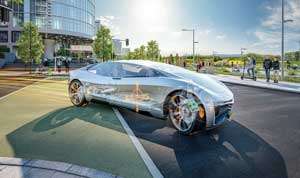German technology company Continental says it has received a major award in the third quarter for the series production of its semi-dry brake system (also known as Future Brake System, FBS), valued about EUR1.5 billion. This success increases the liftetime sales to more than EUR2 billion for this new system. The start of series production with a North American car manufacturer is planned for 2025.
Continental will be introducing a technology change at its customer from wet to a semi-dry-brake system, which will include several new components. Continental’s Future Brake System uses electromechanical brakes on the rear axle which are operated “dry”, without brake fluid. On the front axle, the wheel brakes continue to be operated hydraulically. The new technology also includes the second-generation brake-by-wire system MK C2. In addition to the semi-dry brake system, the car manufacturer also ordered Continental Air Supply, a highly integrated air supply system used in combination with air springs on the front and rear axles for air suspension.
“We are very happy about the first business award for our Future Brake System. This success combines the introduction of future technology with a significant order intake. It shows that we are successfully shaping the future of brake systems and that our brake systems meet the future needs and requirements of trends like automated driving and electrification,” said Matthias Matic, Head of Business Area Safety and Motion at Continental.
While vehicle architectures are undergoing fundamental changes towards a zone-based architecture, brake systems are becoming increasingly intelligent to meet the future needs and requirements of automated driving, electrification and digitalisation. In line with its goal of Vision Zero, Continental is committed to improving traffic safety for everyone. That is why the company is driving the development of Future Brake Systems that are primarily used in vehicles with modified architectures. The FBS gives the car manufacturer the freedom to go to a smart actuator hardware where the software can be distributed on any electronic control unit to ensure safety redundancy and offering flexibility to the customers – a further step towards the software-defined vehicle. Continental’s FBS roadmap not only demonstrates market readiness with this new customer award, but it also highlights that the company is well prepared and positioned to lead this change.
Ranging from FBS 0 to FBS 3, Continental’s roadmap shows the evolution of brake controls to motion systems and draws the path towards completely “dry” brakes at the rear and front axles. At the beginning of this roadmap (FBS 0) is the award-winning, second generation of Continental’s brake-by-wire system MK C2 brake system as the gateway into all Future Brake Systems. The generations that build on this are intended to further strengthen Continental’s position as one of the market leaders in one-box brake-by-wire systems. In the next development step (FBS 1), it is no longer necessary to mount the system directly at a specific location on the firewall in front of the driver to enable mechanical fallback. Instead, an electronic pedal supports new vehicle concepts involving different vehicle interiors and dimensions, such as the skateboard chassis of electrified vehicles, on which various bodies can be mounted.
With FBS 2, the brake system starts to become “dry on one axle”. Matic explained: “Some customers are currently requesting this intermediate step before going dry on all corners. The first step is to no longer actuate the brakes hydraulically on the rear axle. The received order is the best proof point for that development.” For vehicle manufacturers, this decentralisation also means “breaking up” the conventional architecture, and further increasing the degree of freedom of vehicle architectures.
Finally, with FBS 3, the brake system can be broken up into modules. In the long-term view, the hydraulic system could be eliminated completely including all fluids thus contributing to sustainability. “To achieve this, all four-wheel corners could be actuated electromechanically and would be completely ‘dry’,” Matic added. “Individual functions of a brake system will be packaged as stand-alone products in modular, validated and proven software blocks.”

